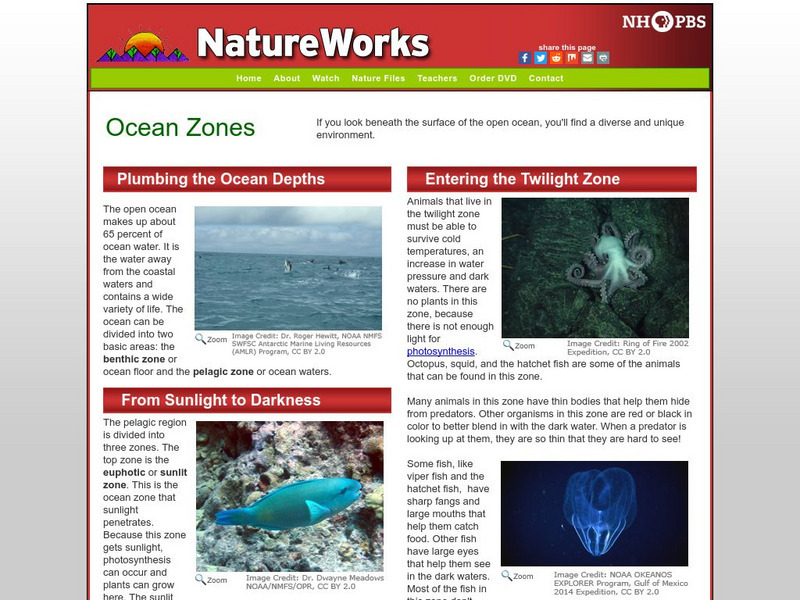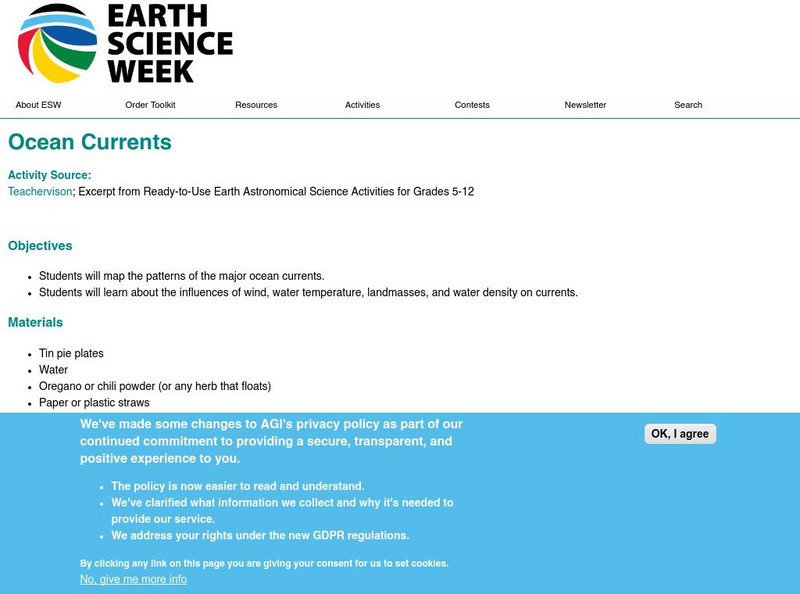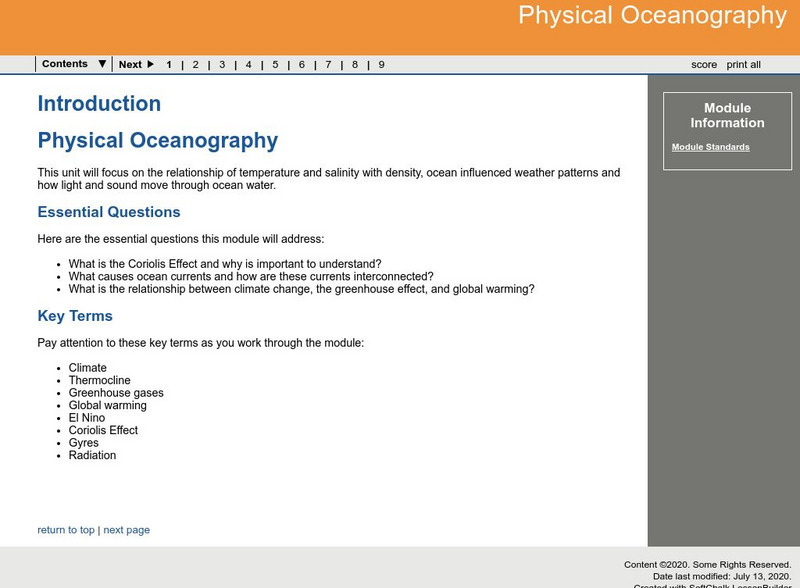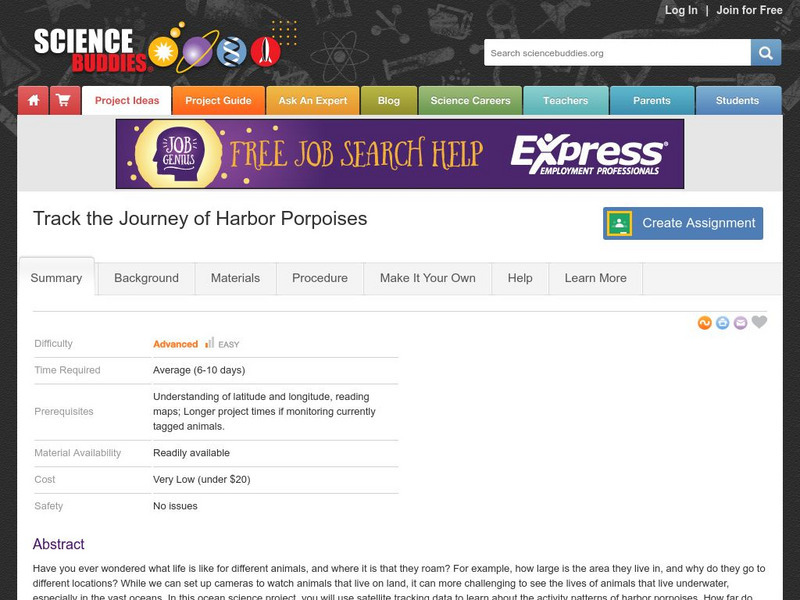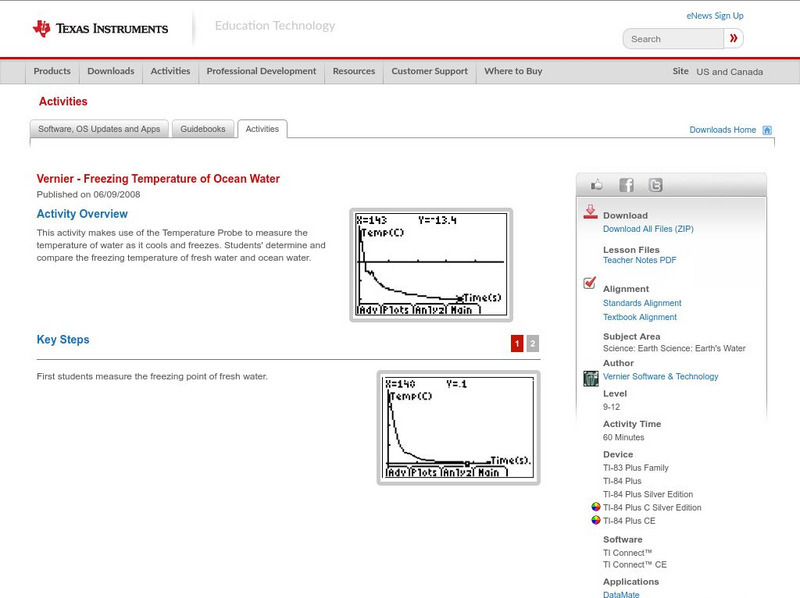Hi, what do you want to do?
NASA
Nasa Earth Observatory: Global Maps: Sea Surface Temperature
This global map from NASA's Earth Observatory shows the sea surface temperature from July 2002 to October 2008. Learn the influences that sea surface temperature has on climate and weather.
PBS
Nh Pbs: Nature Works: Ocean Zones
Discover more about the underocean environment at this site that surveys animals, environmental factors such as light and temperature, currents, animals, plants, and the like.
US Navy
Office of Naval Research: Ocean Water
This highly informative site delves into salinity, pressure, density, temperature acoustics, and optics associated with ocean water. A quick quiz follows the information presented.
Society for Science and the Public
Science News for Students: Climate Change Could Stall Atlantic Ocean Current
When carbon dioxide levels rise, the currents slow, which leads to temperatures dropping because of the lack of water movement. Europe could suffer as a result of this change.
Climate Literacy
Clean: Ocean Currents and Sea Surface Temperature
To discover the link between ocean temperatures and currents as related to our concern for current climate change.
American Geosciences Institute
American Geosciences Institute: Earth Science Week: Ocean Currents
Students map the patterns of the major ocean currents, and learn about the influences of wind, water temperature, landmasses, and water density on currents.
Encyclopedia of Earth
Encyclopedia of Earth: Atlantic Ocean
Information on the features, size, salinity, temperature, ocean floor, currents, and tides of the Atlantic Ocean.
NASA
Nasa Earth Observatory: Ocean and Climate Fact Sheet
Read about Earth's oceans and the effects that climate have had on the rising temperatures over the past one hundred years. Discover how the Earth's ocean and atmosphere are interlocked so that when one changes, the other is affected.
Science Education Resource Center at Carleton College
Serc: Detecting El Nino in Sea Surface Temperature Data
Through data analysis and observations of patterns, students learn about normal seasonal sea surface temperature variation as well as extreme variation, as in the case of El Nino and La Nina events, in the equatorial Pacific Ocean.
Science Education Resource Center at Carleton College
Serc: How Does the Temperature of the Great Lakes Change Over Time?
This activity allows students to use water surface temperature, bathymetric data, and weather data to look at trends in the water temperature of the Great Lakes.
Georgia Department of Education
Ga Virtual Learning: Physical Oceanography
A student learning module with a focus on the relationship of temperature and salinity with density, ocean-influenced weather patterns, and how light and sound move through ocean water.
Science Buddies
Science Buddies: Ocean Currents: Modeling 'Global Conveyor Belt' in Your Kitchen
Ocean currents have a profound effect on the climates of the continents, especially those regions bordering on the ocean. The Gulf Stream makes northwest Europe much more temperate than any other region at the same latitude, and the...
NOAA
Noaa: Ocean Explorer: Hot, Cold, Fresh and Salty
Students simulate ocean water characteristics in order to recognize that the effects of salinity and temperature are the drivers of thermohaline circulation.
NASA
Nasa: Ocean Motion: Wind Driven Surface Currents: Upwelling and Downwelling
Explains what upwelling and downwelling of ocean currents are, and the impact of Ekman transport and the Coriolis effect on current movement as well as where they occur. The effects of upwelling and downwelling on water temperature and...
E-learning for Kids
E Learning for Kids: Science: Atlantic Ocean: What Is Evaporation?
Explore with Julia how wind speed and temperature affect evaporation rate.
Science Education Resource Center at Carleton College
Serc: Ocean Water: Density
In this instructional activity students will learn about the stratification of the ocean by using a simulation to show the different densities. The simulation explores how temperature, salinity, and wind affect the development of water...
Science Buddies
Science Buddies: Harbor Porpoise Movement
In this project you can use archived satellite tracking data to learn about activity patterns of harbor porpoises. How far do they travel? Can you find patterns in the routes individual animals take? Can you correlate their route with...
Science Buddies
Science Buddies: Do Warmer Seas Make Stronger Hurricanes?
We've all heard that hurricanes draw their immense power from warm ocean waters. Of course, many factors contribute to the formation and growth of a hurricane, but can we expect to find that the warmer the water, the stronger the...
Other
Rutgers Marine & Coastal Sciences: Cool Classroom
Students and teachers can explore the work of marine scientists and observe the ocean from their computers. Learn about Rutgers Coastal Ocean Observation Laboratory, discover why oceanography is important, and see what life is like in...
Rice University
Rice University: Museums Teaching Planet Earth: What Is the Hydrosphere?
Focus is on the hydrosphere and contains the definition as well as characteristics of the ocean and the effect of the ocean on climate.
US Navy
Naval Research Office: Ocean Water: Temperature Scales
For an overview of the four temperature scales, visit this site. General information is given about the scales including their boiling and melting points.
Texas Instruments
Texas Instruments: Freezing Temperature of Ocean Water
This activity makes use of the Temperature Probe to measure the temperature of water as it cools and freezes. Students' determine and compare the freezing temperature of fresh water and ocean water.
E-learning for Kids
E Learning for Kids: Science: Atlantic Ocean: What Is Temperature?
Students learn the difference between heat and temperature, how temperature is measured, and about the Celsius scale.
E-learning for Kids
E Learning for Kids: Science: Atlantic Ocean: What Is the Water Cycle?
Explains the three states of water, how the water cycle works, and the role of temperature. Includes a fun fact quiz.






